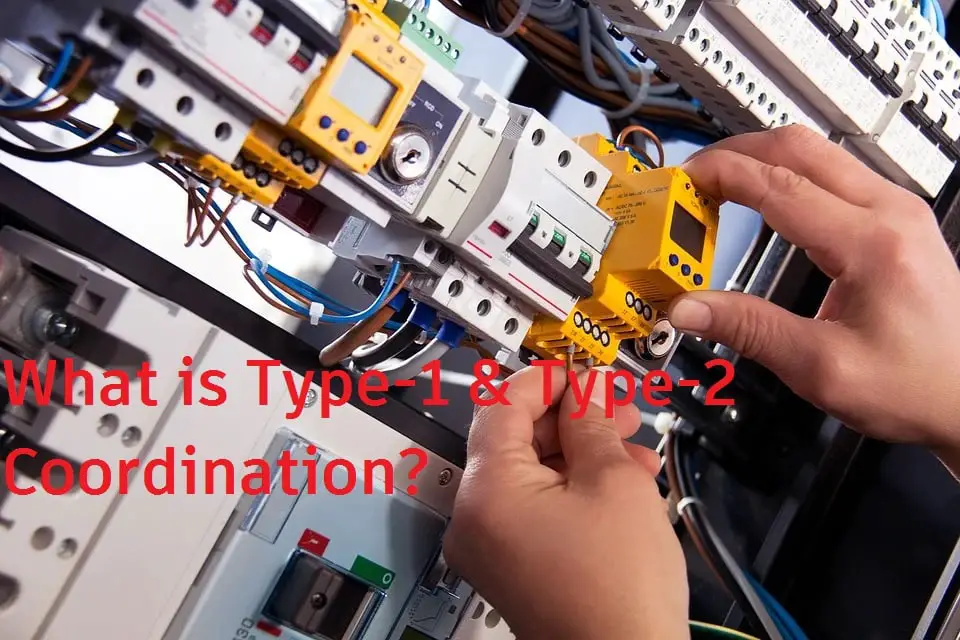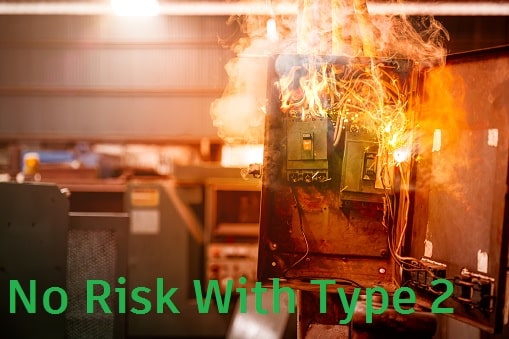Table of Page Contents
What is Type 1 and Type 2 Coordination?
Type 1 and Type 2 coordination indicates the criteria of short-circuit performance of motor starter components. The IEC set out the criteria for the type 1 and type 2 coordination. The IEC standard is 60947-4-1. It defines levels of the motor controller’s resilience that follows a short-circuit fault.
To attain this performance as per Type1 and Type 2 coordination, a mixture of starter components like fuses, contactor and protection device should meet the required criteria stated by IEC 60947 4-1. In this post, we will discuss what is type1 coordination and type 2 coordination.

What is Type 1 coordination?
Type 1 coordination demands that the motor starter should not cause any damage to the electrical installation, and the person during short-circuit situation. And, after clearing the fault, the motor starter is no longer appropriate for an use without repairing of motor starter components.
During short circuit fault, the contactor’s contacts of the motor starter may weld. The overload relay may get damage.
Thus, in type-1 coordination
- The motor starter protects the electrical equipment and human.
- During short circuit fault, the motor starter components get damage.
- The starter components needs to repair for reuse of the motor starter
We take an example of motor starter with motor to understand Type-1 coordination. A large current flows through the starter components during the short circuit condition. This large current heat up the contactor contacts.
And, at the time of tripping of the contactor with short circuit fault by overload relay, the contact may get weld. Thus, after clearing of fault, the motor starter can not be used immediately. The starter or starter component needs replacement for the next use.
The replacement of the motor starter or defective motor starter parts takes a substantial time. The production loss happens during this repair/replacement period. Thus, the Type-1 coordination is not economic for the industry. Also, the type-1 coordination is not suitable for the electrical installation having a large fault level.
What is Type 2 coordination?
We can solve the problem of motor starter damage problem of Type 1 coordination with an use of IEC standard Type-2 coordination. In type 2 coordination, the coordination between the tripping device and the fault isolation device is such that the no parts of the starter get damage during interruption of the short circuit current.
- No damage to the motor starter parts. And, the starter can be used without repairs.
- No downtime
- The motor can be started after clearing the fault.
- No welded contacts
- Welding acceptable provided contacts can be easily separated.
In type-2 motor starter, the motor protection relay senses the fault current. when the current exceeds above the set point, the relay issues trip command to the contactor that isolates the faulty section in no time. The relay current sensing is very fast, and it trips the contactor before reaching the prospective fault current to peak value.
Thus, the type-2 coordination ensure no risk and no damage to motor controller for downstream faults.
What Starter parts involved in Type 2 ?
The thermal overload relay, contactor/ circuit breaker combination is selected that certified for Type 2.
Advantages of Type 2 coordination
- Increased production and productivity: We can start the plant immediately after tripping of the drive. It reduces the idle running of the group drives. Thus, the production and the productivity of the plant enhance.
- Enhancement of Safety: The type-2 coordination enhance the safety of the equipment and people. The motor trips quickly after short circuit fault, and the probability of the fire and other damage consequences reduce.

- Less maintenance cost: There is no damage in motor starter and its parts with Type 2 coordination. Though the initial investment cost is higher, but the maintenance cost is lower.
Read Next: